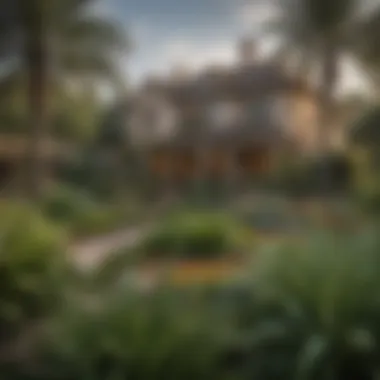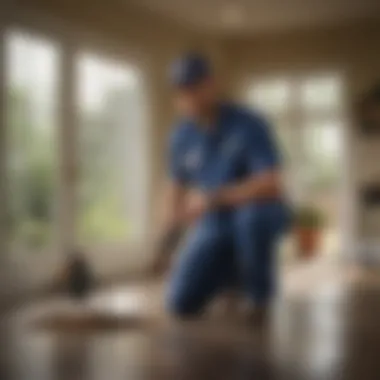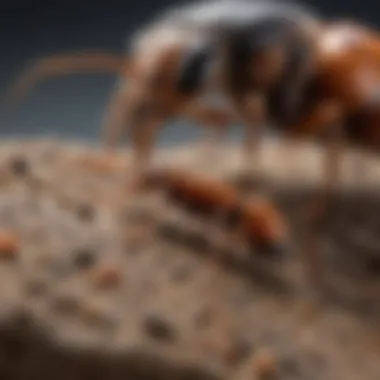Effective Pest Control Strategies in Kissimmee


Intro
In Kissimmee, the challenge of pest control extends beyond mere annoyance. Various pests thrive in this unique environment, where moisture and warm temperatures create ideal breeding conditions. Understanding the local pest landscape is vital for homeowners seeking effective solutions. This article delves into practical strategies that encompass identification, prevention, and treatment, aiming to enhance the quality of life for residents.
Pest Identification
Identifying pests accurately is the first step in effective control. Knowing which pests are common in Kissimmee can help homeowners take proactive measures.
Common Household Pests
Pests that frequently invade homes in Kissimmee include:
- Ants: Carpenter ants or fire ants often invade kitchens or yards.
- Termites: Subterranean termites can cause structural damage if left untreated.
- Rodents: Mice and rats may enter homes seeking shelter and food.
- Cockroaches: Commonly found in warmer areas, they prefer dark and moist environments.
- Mosquitoes: The humid climate supports large populations, especially during summer.
Understanding these pests is crucial to addressing infestations before they escalate.
Signs of Infestation
Recognizing the signs of a pest infestation early can save homeowners time and money. Look for:
- Droppings: Small pellets or streaks often indicate rodent presence.
- Bites and Stings: Unexplained bites could suggest pests like mosquitoes or bed bugs.
- Nesting Materials: Shredded paper or fabric may signal rodent nests.
- Damage: Chewed wires or wood often signifies termite or rodent activity.
- Scent: Unusual odors, especially from kitchens, may indicate insect infestations.
Remember: Early detection is key for successful pest management.
Prevention Methods
Preventing pests from entering a home requires a combination of environmental adjustments and regular maintenance.
Environmental Modifications
Making changes to the environment can significantly reduce the likelihood of pest infestations. Consider:
- Eliminating Standing Water: Pests like mosquitoes require water to breed.
- Sealing Entry Points: Use caulk and screens to block gaps around windows, doors, and vents.
- Trimming Vegetation: Keep plants and shrubs well-trimmed to prevent pests from accessing buildings.
Home Maintenance Tips
Routine home maintenance can prevent pest problems before they start. Here are important actions:
- Regular Cleaning: Maintain cleanliness in kitchens and dining areas to avoid attracting pests.
- Proper Food Storage: Store food in airtight containers to prevent pest accessibility.
- Dispose of Trash: Ensure garbage cans are covered and emptied regularly.
DIY Pest Control Solutions
For homeowners interested in handling pest issues themselves, various natural remedies and preventive methods can be employed.
Natural Remedies
Several natural solutions can help manage pests without toxic chemicals:
- Diatomaceous Earth: This substance is effective for controlling insects by causing dehydration.
- Essential Oils: Peppermint or tea tree oil can deter pests like spiders and ants.
- Vinegar: Mixing vinegar with water can create a repellent spray for ants and cockroaches.
DIY Traps and Barriers
Homemade traps can effectively manage pest populations.
- Trap for Rodents: Baited traps with peanut butter can lure and catch mice.
- Sticky Traps: Place sticky traps near entry routes for cockroaches and other insects.
- Physical Barriers: Installing door sweeps and window screens can keep pests out.
Implementing these strategies can help Kissimmee residents manage pest control challenges effectively.
Understanding Pest Control
Understanding pest control is critical to maintaining a safe and healthy environment in Kissimmee. Effective pest management strategies not only reduce the presence of unwanted insects and rodents but also protect property and ensure the well-being of residents. By grasping the fundamentals of pest control, homeowners can make informed decisions about the methods that best suit their needs.
Definition and Importance
Pest control refers to the management of species that are considered harmful to human health or the environment. Its importance lies in preventing pest-related health issues and minimizing damage to property. Effective pest control ensures that individuals and families can enjoy their homes free from the potential hazards caused by pests.
Understanding how to control pests is especially crucial in Kissimmee due to its warm climate, which attracts various insects and rodents. Awareness of this topic enables homeowners to implement proactive measures, which can lead to long-term solutions rather than temporary fixes.
Types of Pest Control
Knowledge of the different types of pest control helps individuals select the most effective methods for their specific situations. Here are the main types of pest control approaches:
Preventive Pest Control
Preventive pest control focuses on eliminating conditions that invite pests. This includes maintaining cleanliness in and around the home, sealing entry points, and managing waste properly. The key characteristic of preventive pest control is its proactive nature. Homeowners can significantly reduce pest occurrence by taking these measures. It is a beneficial choice as it promotes long-term pest management without the constant need for treatments. A unique feature is the low environmental impact compared to other methods. However, some may find it requires continuous effort and vigilance.
Chemical Pest Control
Chemical pest control involves using pesticides and other chemical agents to eliminate pests. This method can be effective in quickly reducing pest populations. The key characteristic here is the immediate impact of pesticides, which make it a popular choice for urgent pest problems. A unique feature of chemical pest control is its ability to target specific pest types. However, disadvantages include potential environmental harm and risks to human health if misused. It is crucial that users follow label instructions carefully to mitigate these dangers.
Biological Pest Control
Biological pest control utilizes natural predators or pathogens to control pest populations. This approach is often seen as an environmental-friendly alternative. The key characteristic of biological pest control is its reliance on natural processes rather than chemicals. It is beneficial because it encourages ecological balance and reduces the chemical footprint in the area. A unique feature is the promotion of biodiversity. This method may have limitations, as it can take time to see results and may not address acute infestations effectively.
Integrated Pest Management


Integrated Pest Management (IPM) combines multiple strategies for a comprehensive approach to pest control. It considers the lifecycle of pests and how they interact with the environment. The key characteristic of IPM is its holistic approach, making it popular among environmentally conscious homeowners. A unique feature is its adaptability, as it evolves based on ongoing monitoring and assessment of pest populations. The downside is that it requires knowledge and commitment, which might be overwhelming for some homeowners.
Pest Identification in Kissimmee
Effective pest control relies heavily on accurate pest identification. Knowing the specific pests prevalent in Kissimmee enables homeowners to address issues efficiently. This understanding helps in selecting the appropriate control strategies and prevents potential damages to properties. Additionally, recognizing signs of infestation early can save time and resources.
Common Pests in the Region
Ants
Ants are social insects that can form large colonies, often leading them to invade homes in search of food. They are known for their ability to exploit even the smallest openings in structures. The presence of ants can indicate a larger problem in the area. Their abundance in Kissimmee makes them a common concern. They usually leave behind pheromones, which are chemical signals that attract others to food sources. While ants can be seen as harmless, certain species, like fire ants, can cause painful stings. Identifying the type of ant can inform the best control method.
Termites
Termites are notorious for causing extensive damage to wooden structures. They thrive in warm, humid environments, making Kissimmee an ideal habitat. Recognizing termite activity is crucial, as they often go unnoticed until significant damage has occurred. Key features include mud tubes, discarded wings, and hollow-sounding wood. The economic impact of termite infestations can be severe, emphasizing the importance of identification and prevention. There are various types of termites, and knowing which type has infested a property can influence treatment strategies.
Spiders
Spiders vary greatly in behavior and habitat. They play a vital role in controlling pests, but some species can be dangerous to humans. Common spiders in Kissimmee include the brown recluse and black widow. Knowing how to identify these spiders can help prevent bites and allergic reactions. They often build webs in quiet, undisturbed areas, which can be a sign of their presence. Identification is key to balance; while some spiders are beneficial, others may require removal.
Rodents
Rodents, including rats and mice, are often associated with unsanitary conditions. They reproduce quickly and can carry diseases, making their control essential. Signs of rodent presence include droppings, gnaw marks, and nesting materials. Their adaptability to various environments makes them difficult to eliminate without proper identification. Understanding their behavior helps in developing effective control strategies, from traps to exclusion methods.
Bed Bugs
Bed bugs have become a growing concern in many areas, including Kissimmee. These pests feed on blood, and their bites can cause irritation. They are known for their elusive nature and can multiply rapidly. Identifying bed bugs involves looking for small, reddish-brown insects, shed skins, and tiny black spots, which are fecal matter. Their presence can disrupt sleep and lead to discomfort and anxiety in affected individuals. Early identification is crucial in managing infestations effectively.
Identifying Pest Signs
Physical Damage
Physical damage from pests can take various forms, such as chewed wires, gnawed furniture, or structural damage. Examining these signs helps in identifying the types of pests present and determining their numbers. Each type of pest leaves unique damage patterns, which can guide homeowners in choosing appropriate control methods. Prompt attention to physical damage can prevent further escalation of the problem, helping to maintain the integrity of the home.
Excrement Samples
Pest droppings can provide valuable information about the type of infestation and the severity of the problem. Each species tends to leave droppings that have distinct characteristics regarding size and shape. For instance, mouse droppings are small and cylindrical, while rat droppings are larger and might have pointed ends. Identifying the droppings can help in swift identification of the pest and aid in initiating timely treatment strategies.
Nests and Habitats
Nests and habitats indicate established pest populations. Identifying where pests are nesting can lead to more effective control measures. Various pests build specific types of nests that provide insight into their behavior and habitat preferences. For example, rodents may create nests in warm, dark areas, while ants may build mounds in soil. Recognizing these areas allows homeowners to target efforts to reduce the population effectively.
Understanding and identifying pests is a crucial component of effective pest control. Without accurate identification, treatment choices may be misdirected and ineffective.
Preventive Measures
Preventive measures are a critical component of pest control strategies in Kissimmee. These measures focus on stopping pest problems before they arise, thus reducing the need for more aggressive pest control methods later. Employing preventive measures saves homeowners time, money, and emotional stress. It also supports environmental sustainability by minimizing chemical usage.
Home Maintenance Tips
Sealing Entry Points
Sealing entry points is an effective method to keep pests at bay. Pests often enter homes through tiny openings in walls, windows, and doors. By sealing these entry points, homeowners can significantly reduce the likelihood of infestations. The key characteristic of sealing entry points is its proactive nature. It is an easy and cost-effective choice for pest prevention.
The unique feature of sealing entry points includes using materials like caulk, weather stripping, and door sweeps. This strategy's advantage lies in its ability to create a physical barrier against pests. However, one potential disadvantage is that it requires regular inspection and maintenance to ensure all openings remain sealed and effective.
Proper Waste Management
Proper waste management is essential for preventing pest invasions. Food waste is an attractive lure for many pests, including rodents and insects. Therefore, maintaining cleanliness in and around the home is vital. The key characteristic of proper waste management is its direct impact on the pest population. It is a simple yet powerful choice for homeowners in Kissimmee.
Using secure bins with tight-fitting lids is a unique feature of this strategy. Such bins can help contain odors and limit pest attraction. The advantage of proper waste management includes reducing the food sources available to pests. A potential disadvantage may be the effort required to maintain consistent cleanliness, especially in busy households.
Moisture Control
Moisture control plays a significant role in pest prevention. Many pests thrive in humid environments. By managing moisture levels in and around the home, homeowners can deter pests effectively. The key characteristic of moisture control is its ability to limit breeding grounds for pests. It is a beneficial strategy that addresses one of the primary needs for pests' survival.
A unique feature of moisture control is the use of dehumidifiers and proper ventilation. These tools can help reduce humidity in basements and kitchens. The advantage of moisture control is that it not only helps prevent pests but also improves indoor air quality. A disadvantage could be the initial cost of dehumidifiers or renovations needed for proper ventilation.
Landscaping Considerations
Landscaping plays a crucial role in pest management. The choices made in the garden can attract or repel various pests. Understanding how to manipulate landscaping elements can serve as an effective preventive measure.
Choosing the Right Plants
Choosing the right plants can significantly impact pest control in Kissimmee. Native plants are generally better suited to the local environment and often require less maintenance. Their natural resilience can make them less prone to pest problems. The key characteristic of this practice is its focus on biodiversity. It presents a sustainable choice that benefits the entire ecosystem.
Incorporating pest-resistant varieties is a unique feature of this tactic. Plants like marigolds or lavender can deter some pests due to their scents. The advantage of this approach lies in creating a more harmonious environment while keeping pests away. The disadvantage, however, can be the initial costs of replacing non-native plants with appropriate alternatives.
Maintaining Lawn Health
Maintaining lawn health influences pest presence significantly. A healthy lawn can resist pest infestations and support overall ecosystem balance. The key characteristic of maintaining lawn health is its preventive nature through regular care, such as mowing, watering, and fertilizing. This is a popular choice among homeowners who want an appealing outdoor space.
One unique feature of healthy lawns is the presence of beneficial microorganisms in the soil that can suppress pest populations. The advantage of maintaining lawn health is its dual benefit: fostering a beautiful landscape while serving as a barrier against pests. Conversely, a potential disadvantage is the time and effort required to keep the lawn well-maintained throughout different seasons.
Chemical Pest Control Options
Chemical pest control options play a crucial role in effective pest management strategies. These methods use synthetic and natural substances to exterminate or repel unwanted species. Targeted application of pesticides can control pest populations effectively, ensuring a more balanced environment in residential areas. However, it is essential to choose the right chemicals and apply them responsibly to minimize potential risks to humans, pets, and non-target organisms. Understanding the types of pesticides available and following safe practices ensures optimal results in managing pest issues.


Pesticide Types
Insecticides
Insecticides are chemicals designed specifically to kill or control insects. They are an important component of pest control in Kissimmee, given the variety of insect pests that can affect homes. The effectiveness of insecticides is one of their key characteristics, as they target pests such as ants, termites, and bed bugs quickly and efficiently.
A unique feature of insecticides is their diverse formulations, which can cater to different pest control requirements. They can be classified as contact insecticides, which kill insects on contact, or systemic insecticides, which enter the plant system, targeting pests that feed on it. While the advantages of insecticides include rapid action and effectiveness against a range of pests, they also have disadvantages. Misuse can lead to resistance in pest populations and adverse impacts on beneficial insects.
Herbicides
Herbicides target unwanted plants, or weeds, that compete with desirable vegetation. Their role in pest control is significant, particularly in maintaining garden health and aesthetics. The key characteristic of herbicides is their ability to selectively kill specific types of plants while sparing others, making them useful for both agricultural and residential settings.
A notable advantage of herbicides is their capacity to alleviate plant competition, allowing desired plants to thrive. However, their unique feature of sometimes affecting non-target plants – especially if not applied correctly – is a concern. This means homeowners must be vigilant to prevent unintended damage to their landscaping.
Rodenticides
Rodenticides are designed to control rodent populations, which can cause significant damage to property and pose health risks. Their effectiveness stems from their strong formulations that target rodents like rats and mice effectively. The key characteristic of rodenticides is their potency; a small amount can eliminate larger pests, making them a popular choice in residential pest control.
Rodenticides have a unique feature as they often come in bait stations that help isolate the poisons and protect children and pets. This controlled approach is an advantage. However, it is important to know that rodenticides can have severe consequences for non-target species if ingested. Therefore, users must use caution and follow the recommended guidelines when using these products.
Safe Application Practices
Safe application practices are essential when utilizing chemical pest control options. They ensure that the application does not result in harm to the user or the environment.
Wearing Protective Gear
Wearing protective gear is a pivotal aspect of applying pesticides safely. This gear typically includes gloves, goggles, and long sleeves, which protect the skin and eyes from chemical exposure. Protective clothing is a beneficial choice in pest control practices as it reduces the risk of direct contact with harmful substances.
A unique feature of wearing protective gear is that it empowers users to handle chemicals more confidently, knowing that they are safeguarded against potential hazards. Ensuring proper protection is essential not only for safety but also for maximizing efficacy in treatments for pests.
Following Label Instructions
Following label instructions is a fundamental practice in pesticide application. Each product includes specific guidelines regarding dosage, application technique, and safety precautions. This adherence is critical for achieving effective results while minimizing environmental impacts.
The main advantage of following label instructions is that it ensures compliance with state regulations, promoting responsible pesticide use. Additionally, products may have specific features regarding how and when to apply for optimal control. Ignoring these details can lead to ineffective treatments or dangerous consequences for the user and surrounding ecosystem.
"Proper application of pesticides not only ensures effective pest management but also safeguards the health of the community and environment."
In summary, chemical pest control options are a vital aspect of comprehensive pest management strategies in Kissimmee. Each pesticide type serves a distinct purpose, and safe application practices are necessary to maximize their benefits while mitigating risks.
Biological Pest Control Methods
Biological pest control methods hold significant importance in addressing pest challenges. They leverage natural enemies to reduce pest populations, often presenting a sustainable approach for homeowners. The main benefit of biological control is the minimal environmental impact compared to traditional chemical treatments. Rather than indiscriminate application of pesticides, biological strategies foster ecological balance, protecting beneficial organisms. This article will explore various biological pest control methods, particularly the utilization of natural predators and microbial agents.
Natural Predators
Beneficial Insects
Beneficial insects play a crucial role in pest management. These insects include ladybugs, lacewings, and predatory mites, all of which target harmful pests like aphids and spider mites. One key characteristic of beneficial insects is their ability to reproduce quickly, allowing them to maintain numerous pest populations under control.
Ladybugs, for example, can consume up to 50 aphids a day, making them a popular choice in biological pest control. However, a unique feature of beneficial insects is their dependency on a stable habitat that provides food and shelter. They thrive in diverse environments, which means homeowners must cultivate a suitable landscape to ensure their effectiveness. Plus, while they are generally low-risk, there’s a need for careful consideration when introducing them into the ecosystem.
Birds and Bats
Birds and bats also represent effective biological pest control agents. These creatures help control insect populations, maintaining natural balance in Kissimmee's ecosystems. A significant characteristic of both birds and bats is their capacity to consume large quantities of insects. For instance, a single bat can eat over 1,000 mosquitoes in one night, which makes them highly beneficial for residential areas.
Moreover, the unique feature of birds and bats is their ability to cover vast areas during their feeding activities, providing control over multiple pest colonies. However, their dependence on specific nesting sites may pose challenges. Encouraging these animals involves creating suitable habitats, such as bat houses or bird feeders. The introduction of these natural predators fosters a more sustainable pest management strategy.
Microbial Agents
Microbial agents involve the application of specific microorganisms to target pests. These include bacteria, fungi, and viruses that can be harmful to mosquitoes, locusts, and other pests but safe for humans and beneficial insects.
One of the key advantages of microbial agents is their specificity; they are often effective against certain pests without adversely affecting other organisms. For example, Bacillus thuringiensis is a bacterium that effectively kills caterpillars but poses no threat to bees or other insects. Furthermore, the use of microbial agents reduces reliance on chemical fertilizers and pesticides, promoting a healthier ecosystem.
Integrated Pest Management (IPM)
Integrated Pest Management, commonly known as IPM, is a significant approach to managing pest issues in Kissimmee. It combines different management strategies and practices to reduce pests and their damage effectively while focusing on long-term prevention. This method emphasizes the health of the ecosystem, aiming to minimize the use of chemicals, protect non-target species, and safeguard human health. The importance of IPM lies in its balanced approach, which considers the unique characteristics of local pests and environmental factors. By understanding these aspects, homeowners can devise more effective pest control strategies, which can be both economical and eco-friendly.
Principles of IPM
The principles of IPM encompass a variety of strategies aimed at holistic pest management. The core principles include:
- Prevention: Addressing pest problems before they occur by enhancing environmental conditions that deter pests.
- Monitoring: Regular observation and monitoring of pest populations to assess the level of pest activity.
- Identification: Correctly identifying pests to understand their biology and behavior, which can guide control measures.
- Management: Utilizing a combination of methods, including biological, cultural, mechanical, and chemical controls, to manage pest populations.
This balanced approach helps to maintain pest levels below significant economic injury thresholds while also promoting sustainable pest management practices.
Developing an IPM Plan
To create an effective IPM plan, several steps should be taken. This includes the following:
Monitoring and Assessment
In the realm of pest control, Monitoring and Assessment are crucial for identifying pest levels and determining whether action is required. Regular monitoring allows homeowners to observe pest behavior, which can inform future management decisions. One key characteristic of this step is its preventative nature, helping to catch potential infestations early. This is especially beneficial in residential areas where the impact of pest problems can escalate quickly. A unique feature of monitoring is that it can involve simple observations, such as checking for signs of pest activity or setting traps. The advantage of this method is its cost-effectiveness, as it does not always require professional intervention.
Action Thresholds
Action Thresholds are specific points at which pest populations warrant action to prevent unacceptable damage. Establishing these thresholds helps in minimizing unnecessary pesticide use, focusing efforts when pest numbers exceed these limits. This concept is essential for sustainability in pest management. The key characteristic of action thresholds is that they promote decision-making based on data rather than preconceived notions. The downside is that it requires knowledge of pest life cycles and damage potential which may require guidance for some homeowners.


Evaluation and Adaptation
Evaluation and Adaptation involve reviewing the effectiveness of the pest management strategies employed. This is a crucial step as it allows homeowners to assess the success of their IPM plan and adjust accordingly. The key characteristic of this phase is that it fosters continuous improvement, making pest control more efficient over time. A unique feature of evaluation is that it can reveal changing pest patterns, prompting necessary adjustments in strategy. However, one disadvantage is that regular evaluation may require time and effort, which may deter some homeowners from fully implementing it.
"Incorporating IPM not only addresses current pest issues but also lays a framework for long-term sustainability in pest control."
By integrating these components—monitoring, action thresholds, and evaluation—homeowners can develop a thorough IPM plan. Such a plan will not only contribute to effective pest management but will also minimize the negative impact on the environment.
DIY Pest Control Solutions
DIY pest control solutions are increasingly relevant for homeowners seeking to manage pest issues effectively while saving on costs. These methods empower individuals to take charge of their home environments. By using accessible materials and simple techniques, homeowners can mitigate pest populations before they escalate into larger problems.
Homemade Remedies
Natural Repellents
Natural repellents serve as a cornerstone in DIY pest control. They are often made from readily available ingredients such as essential oils or vinegar. Their key characteristic is that they tend to be less toxic compared to traditional chemical repellents. This makes them safer for households, especially those with children or pets.
Some of the most popular natural repellents include peppermint oil, which deters ants and spiders. Moreover, citric acid, commonly found in lemon juice, acts as a powerful deterrent against various insects. The unique feature of these natural options is their ability to repel pests without the lingering harmful effects associated with chemical alternatives. However, the efficacy of natural repellents can vary greatly based on concentration and environmental conditions. Homeowners may find that they require frequent reapplication, which could be seen as a disadvantage.
Traps and Barriers
Traps and barriers are practical methods that contribute significantly to the overarching goal of pest control. They focus on physically preventing pests from entering or establishing themselves in the home. A key characteristic of traps is their variety; from sticky traps for insects to bait traps for rodents, there is a solution for different pest types.
Using barriers such as mesh screens or caulking, allows homeowners to block off entry points effectively. The unique feature of this method is that it not only reduces pest populations but also prevents future infestations. However, one must consider the potential downsides such as the need for regular maintenance and the possibility of inadvertently trapping non-target species, which may be a concern for some homeowners.
When to Call Professionals
Determining when to call pest control professionals can be challenging.
Here are a few indicators:
- If DIY methods are ineffective after repeated attempts, it is time to seek expertise.
- The presence of large infestations may pose health risks that require professional intervention.
- Specialized pests, such as termites or bed bugs, often necessitate advanced treatment techniques that are best handled by trained experts.
Calling professionals ensures that treatment is not only effective but also safe and compliant with local regulations.
Environmental Considerations
Environmental considerations are crucial for effective pest control strategies in Kissimmee. The focus is on minimizing negative impacts on the ecosystem while managing pest populations effectively. Understanding environmental factors can lead to more sustainable practices, highlighting the connection between pest control and the health of local surroundings. This balance is essential for maintaining biodiversity and ensuring the long-term compatibility of pest control methods with environmental health.
Impact of Pesticides
Pesticides have distinct effects on various environmental components. Awareness of these impacts is vital for responsible pest management that safeguards ecosystems.
Soil Health
Soil health is a critical aspect of environmental quality. It supports plant life and microbial activity, which play pivotal roles in the ecosystem. Healthy soil enhances biodiversity and promotes water retention, benefiting agricultural practices and natural habitats. Choosing low-toxicity pesticides can help preserve soil health. Using organic matter and minimizing pesticide use protect soil organisms. However, excessive reliance on chemical treatments can lead to soil degradation and loss of fertility.
Water Quality
Water quality is essential for all living organisms. Pesticides can leach into water sources, compromising the integrity of both drinking water and aquatic habitats. Maintaining water quality requires a careful selection of pest control methods that reduce runoff. Integrated pest management often emphasizes practices that protect water bodies. When pesticides enter water sources, they can harm aquatic life and disrupt ecosystems. It's crucial to evaluate pesticide application times and conditions to prevent contamination, ensuring clean water for the community.
Non-target Species
Non-target species, including beneficial insects, birds, and mammals, can be adversely affected by pesticide use. These organisms often play essential roles in pollination and pest control. Protecting non-target species is integral to fostering a balanced ecosystem. Using targeted pesticide options minimizes harm to these species. However, inadequate measures can lead to population declines and disrupt ecological networks. Recognizing and mitigating the risks associated with pesticides helps promote a thriving environment.
Sustainable Pest Control Practices
Shifting towards sustainable pest control practices is critical for environmentally conscious homeowners. It emphasizes methods that are effective yet minimize ecological harm.
Organic Options
Organic options encompass pest control methods that rely on natural ingredients. These can include biological pest control and natural repellents. They contribute to sustainable practices by reducing chemical exposure to the environment. Organic methods often promote healthier ecosystems, benefiting both plants and wildlife. However, they may require more frequent applications and monitoring to ensure effectiveness, creating a potential challenge for management.
Local Ecosystem Protection
Local ecosystem protection aims to maintain the diversity and functionality of native habitats. Implementing pest management strategies that prioritize natural systems supports the resilience of ecosystems. Protecting local flora and fauna ensures that pest control measures do not disrupt existing ecological balances. While this approach may limit certain chemical treatments, the benefits often outweigh the disadvantages, resulting in a healthier community and environment.
Sustainable pest control is a commitment to the environment, ensuring both effective pest management and protection of vital ecosystems.
Legal and Regulatory Aspects
Understanding the legal and regulatory aspects of pest control in Kissimmee is essential for homeowners, pest control companies, and local authorities. These regulations are not merely bureaucratic red tape; they aim to protect public health and the environment. Adherence to these laws ensures that pest control techniques are safe, effective, and compliant with established guidelines.
Pesticide Regulations in Florida
Pesticide regulations in Florida are governed by various federal, state, and local laws. These rules are put in place to manage how pesticides are used, ensuring that they do not pose a risk to human health, wildlife, or the ecosystem. The Florida Department of Agriculture and Consumer Services (FDACS) oversees pesticide registration, use, and enforcement.
Key Elements of Pesticide Regulations:
- Registration: All pesticides must be registered before they can be sold or used. This process involves rigorous testing and evaluation to ensure safety.
- Use Restrictions: Certain pesticides may have limitations on where and how they can be applied, especially near water bodies to protect the aquatic environment.
- Labeling: Each pesticide product must have clear labeling that includes instructions for safe use, handling, and disposal. Misuse can lead to legal penalties.
These regulations not only safeguard individuals and communities but also promote sustainable pest control strategies that consider long-term environmental impacts.
Licensing for Pest Control Operators
Licensing for pest control operators is another crucial aspect of pest management regulations. Pest control operators in Florida must hold a valid license, which requires passing examinations that cover a range of topics relevant to pest control practices.
Importance of Licensing:
- Competence: Licensed operators demonstrate a recognized level of knowledge and competence. They are trained to use specific products correctly and apply safe techniques.
- Accountability: Licensing creates accountability. If an operator mishandles a pesticide application, consumers have a recourse through regulatory bodies.
- Public Trust: Homeowners are more likely to engage with certified pest control professionals, knowing that they adhere to local and state regulations.
Overall, the legal and regulatory aspects surrounding pest control encompass critical considerations necessary for maintaining safety, environmental integrity, and public confidence. Ensuring compliance with these regulations is not just the responsibility of pest control companies, but also a civic duty of homeowners who wish to maintain safe living conditions.















